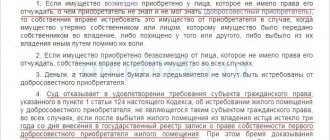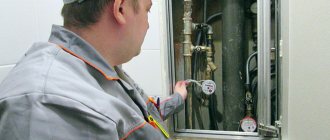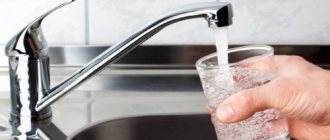Converting cubes to liters
In addition to the usual curiosity, the issue of converting cubes to liters and vice versa is of practical interest - the accounting of consumed water on the meter is indicated in cubic meters.
But such a volume is difficult to visualize, since it is more common to measure liquid in liters.
Therefore, it is important to be able to correctly convert cubic meters into liters in order to know how much water was consumed over a certain period.
Such a calculation is not difficult:
- The volume of one cubic meter is equal to a thousand decimeters.
- A liter of liquid is one cubic decimeter.
- A cube of water is equal to a thousand liters.
The indicated value appears to be abstract.
For clarity, the table below shows the number of operations performed using this amount of water:
| What to do with 1 cubic meter of water (1000 dm3) | Number of times |
| Taking a bath | Thirteen |
| Washing clothes in an automatic machine | Fourteen |
| Shower for one person | Thirty |
| Flush the toilet | One hundred and ten |
From the given data it follows that a cubic meter of water is not so little, but those who believe that you cannot save on small things are wrong.
Note! One leaking faucet in the kitchen will significantly affect the total water consumption for the month.
Considering that a liter of water weighs one kilogram, for a volume of a cubic meter the mass of liquid will be a ton. But here we are talking about distilled water.
It is obtained by passing it through a distillation cube and purifying it from various salts and other dissolved components.
Water charges in 2020 without a meter
The standard number of cubic meters of water per month is as follows: 6 - cold water and 3 - hot. Translated into liters: cold water - 6000 liters, hot - 3000. If the monthly norm is divided by 30, turning it into a daily one, it turns out that the norm of water consumption per day per person is: 200 liters of cold water and 100 liters of hot water. For comparison, the volume of a fully filled bath is 250 liters. Considering that not everyone takes a bath every day, it is easy to understand that the norm is greatly overestimated. By installing water meters in your apartment, you can significantly save on utility bills.
More to read: Single Mother Definition by Law 2020
How to convert to meters, decimeters and centimeters
Convert liters back to cubic meters, decimeters and centimeters.
To calculate how many meters, decimeters and centimeters are contained in one liter of water, you need to perform the reverse operation.
As noted above, one liter is equal to a cubic decimeter. Therefore, in further calculations it is easier to use this volume instead of a liter.
To imagine its relationship to a cube, we should consider what a cubic meter is.
This figure is called a cube with a length, width and height of one meter.
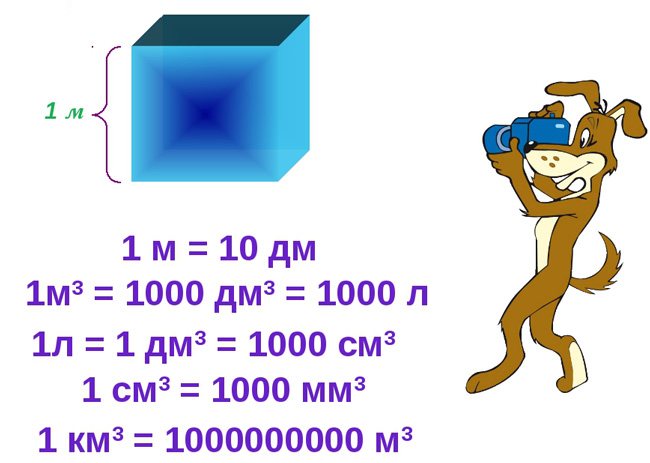
If we recalculate these values in decimeters, we get the following:
- The volume of such a cube in meters is calculated by the formula: 1 m x 1 m x 1 m = 1 m3.
- One meter holds ten decimeters, so if we translate what was noted above, it turns out: 10 dm x 10 dm x 10 dm = 1000 dm3.
- Considering that one decimeter is equal to ten centimeters, it turns out: 10 cm x 10 cm x 10 cm = 1000 cm3.
Based on the above, one liter of water is equal to one thousandth of a cubic meter or a thousand cubic centimeters.
How many cubic meters of gas are in a 50 liter cylinder and how to calculate liquefied gas
For domestic purposes, especially in rural areas, liquefied gas is used in cylinders.
Many people are interested in how to calculate how many cubic meters of gas a standard 50-liter cylinder holds.
It must be taken into account that the blue fuel offered to the population in cylinders is a mixture of propane and butane.
These gases are characterized by the following densities, in kilograms per liter:
- Propane has 0.53.
- Butane has 0.6.
The fact that the volume of the cylinder is 50 cubic meters does not mean the same amount of fuel contained.
According to standards and safety requirements, forty-two liters of liquefied gas are filled into the cylinder.

For the indicated mass of gas with the indicated density, the calculation is as follows:
| Characteristics | Propane | Butane | Unit |
| Density value in the liquid phase | 0,53 | 0,6 | kg/l |
| Volume of filled gas | 42 | 42 | l |
| Weight | 22,18 | 25,24 | kg |
| Density value in the gaseous phase | 1,87 | 2,52 | kg/m. cube |
| A measure of the volume of gas filled into a cylinder | 22,44 | 16,67 | m.cub. |
If propane and butane are poured in equal proportions, the total volume of gas in the cylinder is 20 cubic meters.
What and how determines the cost of water and tariff
In our country there are no problems with water resources, which means the cost of water should not be high. But there is a regular increase in the cost of water tariffs. The latter is related to the process of supplying water to the population and ensuring the operability of communications.
Water price factors
Of course, you can pay less than the estimated cost for 1 cubic meter of water, but in this case you must be on the list of beneficiaries. Those on this list pay half the estimated rate. It includes war and labor veterans, the disabled, and the poor. A complete list can be obtained by contacting your local authorities.
It is also necessary to take into account that at the end of last year there was a certain adjustment to the legislation. Now in apartments/houses where it was possible to install water meters, but the residents themselves refused it, water standards when calculating amounts for consumption are multiplied by a special increasing factor. From which it follows that the installation of individual water meters will allow serious savings on payments for water consumption in 2020.
We recommend reading: Amount of Compensation for Medicines in the Chernobyl Zone
First of all, it should be noted that when calculating the price of services for water consumption, in addition to the cubic meters of water directly consumed by the meter, some indicators related to the maintenance of water supply networks are also taken into account, which include:
How are metered water rates calculated?
If you look at the formation of tariffs for water consumption with and without a meter, then there is no difference. The difference in payment appears only when the apartment does not have a meter; in this case, payment for water is charged in accordance with accepted standards for water consumption per person. Moreover, to obtain the final amount, the tariff is multiplied by the number of people living in the apartment.
You can indicate the type of transaction (purchase, sale, rent) you want to perform, contact information, information about the property, price, and also add a photo to make your ad more popular. In addition to real estate agencies, property owners can also submit advertisements directly, so you can buy or rent an apartment or house without intermediaries.
The document provoking an increase in tariffs was signed by Olga Bobrova. She holds the position of head of the regional service related to tariff regulation. Subsidies have also been preserved for Kemerovo residents. Thus, residents of the regional center will now pay 32.76 rubles for cold water. per cubic meter, drainage – 15.87 rubles. for, for hot water - 33.76 rubles, for heat - 744.88 rubles. per Gcal. From July 1, the electricity tariff for city residents who live in houses with registered stationary electric stoves, as well as for villagers, will be 2.30 rubles/kWh. For other categories of the population – 3.28 rubles/kWh. Tariffs differentiated by time of day will also increase.
In accordance with the text of the letter of the Tariff Department of the Novosibirsk Region dated December 14, 2020 No. 2650-10/33, the value of the specific heat energy consumption for heating the coolant for the open heat supply system of the Federal State Unitary Enterprise "UEV" was determined from July 1, 2020 - in the amount of 0.06201 Gcal/ m 3. According to the Order of the Tariff Department of the Novosibirsk Region No. 726-TE dated December 11, 2020, from January 1 to June 30, 2020, the cost of 1 m 3 of coolant (chemically treated water) is 20.08 rubles, from July 1 to December 31, 2020 - 20.72 rub. Water, which is classified as drinking water, will also become more expensive. Previously, users paid 24.62 rubles for one cube. After July 1, its cost will increase to 24.89 rubles.
We recommend reading: Direct Agreements with RSO and Illegal Consumption
Tariffs for housing and communal services in Kemerovo 2020
As explained in the tariff service of the Irkutsk region, fees for cold, hot water, electricity, thermal energy, gas, domestic gas in cylinders, solid fuel in the presence of stove heating, fees for wastewater disposal, and management of solid municipal waste are established by regulatory authorities in in accordance with Federal laws regulating the procedure for regulating tariffs.
The cost of delivering water to treatment plants will be significantly lower if a reservoir or any body of water is located on the territory of the Kemerovo region facility. Also, the water tariff will be significantly reduced if electrical energy produced by a hydroelectric power station is used and if gas is used to heat water.
Bath capacity
Everyone loves to take a hot bath. But not everyone thinks about the volume of water required for this procedure.
The question about the capacity of the bathtub cannot be answered in monosyllables.
Modern industry produces three types of bathtubs, depending on the material used:
- Made of cast iron.
- Made from acrylic.
- Of steel.
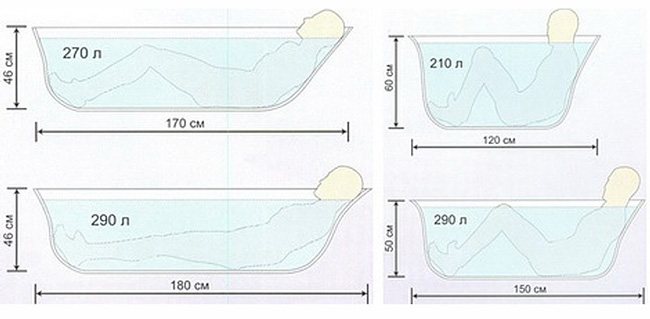
The volume of a product is determined by multiplying its length, width and height.
But it is not always possible to accurately calculate this value, especially when it comes to acrylic bathtubs.
Sometimes performed in an irregular shape, following the contours of the human body, including built-in hoops for holding hands and other delights that make it difficult to accurately determine the volume.
Without boring the reader with lengthy calculations and a large number of numbers, it can be noted that the capacity of the font ranges from one hundred and forty for the smallest models, to two hundred and fifty for huge bathtubs.
The exact parameters are indicated by the manufacturer in the passport of a specific model.
Considering the significant water consumption when taking a bath regularly, a good way to save money is to use a shower. This procedure will require three times less water - about 40.
It is estimated that if you switch from regular bathing to using a shower, the annual savings will be about 37 cubic meters of water.
Another way is to use pre-collected water.
There are many original shower design options on the Internet, including a homemade bucket attached to a hoop, filled with water and turned over using an attached chain.
If you first fill a container with water for washing dishes, washing your face, brushing your teeth for other purposes, you will end up with significant savings.
It is estimated that up to fifteen liters of water escape through an open tap every minute; in an hour this volume will be ninety liters - a considerable consumption.
Considering that more liquid when used by washing dishes and washing under an open tap is wasted, it is worth using the above method to significantly reduce consumption.
Research has established that one person requires about 1000 cubic meters of water annually, if we take into account the costs of producing the goods and products he uses.
But everyone can reduce this figure a little if they take measures to save water in their own home.
And the calculation of the conversion of units will be of considerable help in this regard, in order to represent the scale of the volume of liquid consumed in vain.
How many liters of water in a cube according to the meter in 2020
Many people are interested in the issues of converting units of measurement of various quantities.
In order not to be considered an ignorant person in a company of friends, you need to have an idea of the main points.
Which refer to the ratios of the most commonly used substances when converted into different units of measurement.
The proposed material discusses how many liters of water are contained in 1 cubic meter, how to convert the content of liquefied gas in a cylinder into volume and other related issues.
In addition to the usual curiosity, the issue of converting cubes to liters and vice versa is of practical interest - the accounting of consumed water on the meter is indicated in cubic meters.
But such a volume is difficult to visualize, since it is more common to measure liquid in liters.
Therefore, it is important to be able to correctly convert cubic meters into liters in order to know how much water was consumed over a certain period.
Such a calculation is not difficult:
- The volume of one cubic meter is equal to a thousand decimeters.
- A liter of liquid is one cubic decimeter.
- A cube of water is equal to a thousand liters.
The indicated value appears to be abstract.
For clarity, the table below shows the number of operations performed using this amount of water:
From the given data it follows that a cubic meter of water is not so little, but those who believe that you cannot save on small things are wrong.
Considering that a liter of water weighs one kilogram, for a volume of a cubic meter the mass of liquid will be a ton. But here we are talking about distilled water.
It is obtained by passing it through a distillation cube and purifying it from various salts and other dissolved components.
Convert liters back to cubic meters, decimeters and centimeters.
To calculate how many meters, decimeters and centimeters are contained in one liter of water, you need to perform the reverse operation.
To imagine its relationship to a cube, we should consider what a cubic meter is.
This figure is called a cube with a length, width and height of one meter.
If we recalculate these values in decimeters, we get the following:
- The volume of such a cube in meters is calculated by the formula: 1 m x 1 m x 1 m = 1 m3.
- One meter holds ten decimeters, so if we translate what was noted above, it turns out: 10 dm x 10 dm x 10 dm = 1000 dm3.
- Considering that one decimeter is equal to ten centimeters, it turns out: 10 cm x 10 cm x 10 cm = 1000 cm3.
Based on the above, one liter of water is equal to one thousandth of a cubic meter or a thousand cubic centimeters.
For domestic purposes, especially in rural areas, liquefied gas is used in cylinders.
Many people are interested in how to calculate how many cubic meters of gas a standard 50-liter cylinder holds.
It must be taken into account that the blue fuel offered to the population in cylinders is a mixture of propane and butane.
These gases are characterized by the following densities, in kilograms per liter:
The fact that the volume of the cylinder is 50 cubic meters does not mean the same amount of fuel contained.
For the indicated mass of gas with the indicated density, the calculation is as follows:
If propane and butane are poured in equal proportions, the total volume of gas in the cylinder is 20 cubic meters.
Everyone loves to take a hot bath. But not everyone thinks about the volume of water required for this procedure.
The question about the capacity of the bathtub cannot be answered in monosyllables.
Modern industry produces three types of bathtubs, depending on the material used:
The volume of a product is determined by multiplying its length, width and height.
But it is not always possible to accurately calculate this value, especially when it comes to acrylic bathtubs.
Sometimes performed in an irregular shape, following the contours of the human body, including built-in hoops for holding hands and other delights that make it difficult to accurately determine the volume.
Without boring the reader with lengthy calculations and a large number of numbers, it can be noted that the capacity of the font ranges from one hundred and forty for the smallest models, to two hundred and fifty for huge bathtubs.
The exact parameters are indicated by the manufacturer in the passport of a specific model.
Considering the significant water consumption when taking a bath regularly, a good way to save money is to use a shower. This procedure will require three times less water - about 40.
Another way is to use pre-collected water.
There are many original shower design options on the Internet, including a homemade bucket attached to a hoop, filled with water and turned over using an attached chain.
If you first fill a container with water for washing dishes, washing your face, brushing your teeth for other purposes, you will end up with significant savings.
It is estimated that up to fifteen liters of water escape through an open tap every minute; in an hour this volume will be ninety liters - a considerable consumption.
Considering that more liquid when used by washing dishes and washing under an open tap is wasted, it is worth using the above method to significantly reduce consumption.
But everyone can reduce this figure a little if they take measures to save water in their own home.
And the calculation of the conversion of units will be of considerable help in this regard, in order to represent the scale of the volume of liquid consumed in vain.
Note! If there is a universal meter in a house or entrance, its readings are divided by the number of registered residents minus those apartments where there are individual meters. In addition, water costs for social needs (watering flower beds, washing floors in the entrance, etc.) are deducted separately.
How much 1 cubic meter of cold water and hot water costs for large cities in Russia for the 1st half of 2020 can be found in the table below.
component for coolant - 41.90 rub./cub.m
component for thermal energy, rub./Gcal - 1,902.54
Component for thermal energy, rub./Gcal - 2614.52
*** — tariffs for different areas of the city and region, depending on the service provider.
The following average rates apply for cold and hot water supplies:
- The cost of 1 cubic meter of cold water in Russian cities ranges from 16 rubles. up to 56 rubles.
- The cost of 1 cubic meter of hot water ranges from 87 rubles. and higher.
Separately, it should be noted that benefits are fully preserved. The following categories of citizens are eligible for benefits:
- Pensioners;
- Veterans;
- Persons with disabilities (of any degree);
- Other categories that can count on social protection.
To ensure that the above categories of the population can continue to enjoy subsidies and benefits when paying for utilities in the future, the government has allocated more than 80 billion rubles.
In addition, it should be taken into account that at the end of 2020 there were some adjustments to the legislation. Now, in apartments and houses where it was possible to install water meters, but the residents refused to do so, water standards when billing for water consumption will be multiplied by an increasing factor. From this we can conclude that installing individual water meters will help significantly save on payments for water consumption in 2020.
From the information above, we can conclude that residents of Russian regions will have to pay more for water only from the second half of 2020. Of course, any increase in tariffs cannot be called a pleasant moment for the population. However, if you have installed water meters and know how much a cubic meter of water costs according to the meter, then this increase will not significantly affect your well-being.
If you are unable to pay utility bills, then you should contact the relevant authorities to apply for subsidies. Such subsidies, if allocated, will be able to partially cover the cost of utility bills.
In the receipts received monthly by residents, there is such a column - sewerage. Standards for it are set separately by each region and on average range from 130 to 360 liters per day. They are calculated depending on the region of residence and the degree of improvement of housing.
If the apartment does not have a meter installed, the calculation takes place according to sewerage standards multiplied by the approved tariff. The latter may change periodically, so the total amount on the receipt may also change. This usually happens once a year during the summer months.
If a house meter is installed in the house, then the calculation is made according to its readings. Thus, residents who have their own metering devices pay according to them. And those who do not have such devices pay for the remaining sewerage, taking into account the number of people registered in the apartments.
This is interesting: Gas meter NPM g4: characteristics and verification period 2020
In our country, there are water consumption standards that apply to service users who have not installed meters. So, for hot water they are 3 cubic meters per month, or 100 liters per day per person. If there are more people registered in the apartment, then the water norm increases in proportion to their number.
Cold water is also charged according to the standards established by regulations. The average consumption in Russia is 6 cubic meters per month or 200 liters per day.
This includes the entire volume consumed by 1 person:
- for food and drinking needs;
- hygiene procedures;
- operation of household appliances and cleaning;
- other expenses.
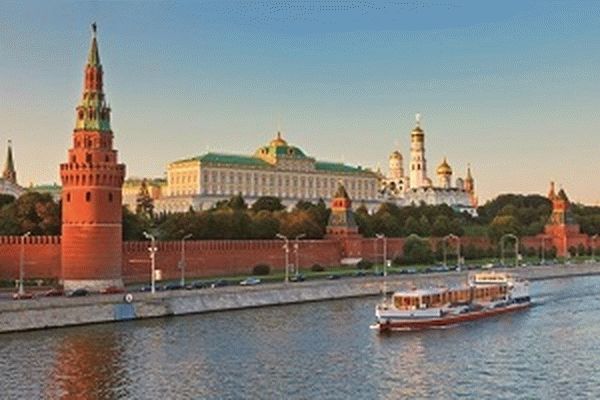
The established standard volumes for the month are:
- 4.7 cubic meters of hot water;
- 6.9 cubic meters of cold water;
- 11.7 cubic meters of drainage.
Muscovites pay for a given amount of consumption according to established tariffs:
- RUB 173.02 for 1 cubic m hot water;
- 35.4 rub. for 1 cubic m cold;
- 21.9 rub. for 1 cubic m of drainage.
This rate is set per person. When 2 or more people live in an apartment, it is multiplied by the appropriate number.
The established consumption standards in apartments without a meter, as a rule, do not correspond to the real needs of people. They are greatly overpriced.
This is partly due to compensation for water losses that occur during accidents and negligence in their duties. After all, when water is drained from the heating system, or a pipe leaks on the street for several days, the loss of resource is very large, and residents have to pay for it at the expense of the volumes established in the standards.
Real consumption is 2-4 times less. Even if a person does not save water, his needs fit into 4 cubes of cold and 3 cubes of hot.
But usually, after installing a meter, people begin to be more attentive to resource consumption and try to avoid unnecessary expenses. This results in significant savings.
So, if hot water costs 150 rubles per 1 cubic meter, the owner will pay not 450 rubles per month, but one and a half or even two times less (about 180 rubles), the savings will be about 300 rubles.
For a family of 3 people, the savings will be about 900 rubles. By summing up the consumption of cold water according to the standards, you get a tangible value for the family budget.
Payment for water consumption can be calculated according to a meter or according to standards. As we found out, the first method is much more profitable for homeowners.
Don't be alarmed, we won't start taking the school physics course all over again. Instead of counting how many liters are in a cubic meter of water, you'll learn about the bucket measurement system and how it helped my family start saving.
Can you tell me what’s incomprehensible here? There are 1000 liters of water in 1 cube, every schoolchild knows this. Well, first of all, not everyone (unfortunately). I have met very intelligent people who believed that a cubic meter consists of 100 liters. Some produced even more exotic versions.
Many people confuse volume and weight, believing that the number of liters of hot, cold and distilled water in 1 cube will be different. Probably the reason is that on the back of school notebooks, instead of a table of units, they began to print photos of Justin Bieber.
But this is not about gaps in education, but about how this information can be used to save the family budget. To do this, we will try to convert the abstract cubic meter into more understandable units. Here are a few examples that give an idea of how many liters are in a cube of water and how they can be used:
- Take a bath 13 times;
- do 14 washes in an automatic machine;
- take a shower 30 times;
- do 111 toilet flushes.
Isn’t it clearer this way? You can immediately see what these same cubic meters are made of and where they go. If desired, the list can be continued indefinitely.
Many are surprised to learn the above figures. This proves that the problem of saving is, to some extent, psychological. It is difficult for us to imagine how many liters of water flow away while we brush our teeth or wash the dishes. After all, we are used to measuring it in cubes, which we see on the utility bill. And such examples give us an idea of the real volume of water consumed.
How to teach yourself and other family members to think in terms of liters rather than cubes? After some thought and futile attempts to change the situation “peacefully”, I did the following. On a warm summer day we went to the village for the weekend, to visit our grandmother...
Immediately after our arrival, the pump in her well suddenly “broke.” There was nothing left to do but attach a bucket and get water the old fashioned way, using a “korba”. For those who don’t know, it’s something like this weird design:
So, in less than two days, the four of us used up 10 buckets of water. I think everyone knows how many liters are in a bucket - 10. After that, I “fixed” the pump and discovered the essence of the experiment. And already at home we made simple calculations.
At that time, our average monthly water consumption was 10 cubic meters for three, that is, 1000 buckets. Divide by 30 days, we get 33 buckets per day, 11 per person. How did the four of us (!) manage to fit into 5 buckets for two days?
Yes, we didn’t do laundry at grandma’s and used, sorry, the “facilities in the yard.” However, an important role in reducing water consumption was played by the fact that to obtain it it was necessary to perform an additional action, and not just turn the tap. Extracting each bucket “by hand” stimulates savings greater than any counter.
Having come to this conclusion, the first thought was to abandon the water supply and dig a well near the entrance.
However, then they decided not to go to extremes, limiting themselves to introducing a “bucket” measurement system. Now, to the question “how many liters of water are in 1 cubic meter”, my daughter answers not “1000 liters”, but “100 buckets”. Simple calculations showed that one bucket of water corresponds to:
- 1 minute in the shower;
- 1 minute of open tap while washing or brushing your teeth;
- flush the toilet with a large button;
- and so on…
I don’t know what had more of an effect: a more visual representation of consumption or the argument “he who doesn’t save water doesn’t spare his grandmother.” However, the very next month we used 2 cubic meters less. Somehow, by itself, the time spent in the shower was reduced, and a glass for brushing teeth appeared on the sink...
Moreover, which is typical, only after this we seriously approached other ways to save water. This allowed us to reduce consumption by another 1 cubic meter. Now we use 6.5-7 cubic meters of water per month, which is quite normal for a family of three.
Additional Information:
Sometimes performed in an irregular shape, following the contours of the human body, including built-in hoops for holding hands and other delights that make it difficult to accurately determine the volume.
- The volume of such a cube in meters is calculated by the formula: 1 m x 1 m x 1 m = 1 m3.
- One meter holds ten decimeters, so if we translate what was noted above, it turns out: 10 dm x 10 dm x 10 dm = 1000 dm3.
- Considering that one decimeter is equal to ten centimeters, it turns out: 10 cm x 10 cm x 10 cm = 1000 cm3.
Also, do not forget that not a single company will operate at a loss, and therefore the cost of each cubic meter of water includes the net profit of the organization organizing its supply.
In addition to how to calculate hot water by meter in 2020, you should also know that the hot water tariff also includes:
Most of the living citizens who have installed resource consumption metering devices in their living space have the opportunity to thus save on paying for the utility services provided to them. However, residents are required to install such devices at their own expense, including the purchase of equipment. The cost of installation will depend on how many meters a person installs. In general, if only one riser passes through the living space, two metering devices are enough - for hot and cold water.
This is interesting: Gas meter SGMN 1 G6 - technical characteristics and advantages 2020
If there is an internal water supply and sewerage system, hot water supply, the coefficients range from 1.25 to 1.15 k/hour. Under the same conditions, in the presence of a bathtub and a gas water heater, the coefficient values are from 1.2 to 1.15 k/hour. The situation is somewhat different with the presence of a bathroom and wood-burning heaters - from 1.4 to 1.2 k/hour. With the presence of internal water supply, but without a bathroom, indicators from 1.6 to 1.4 k/hour are used.
Important! If a water meter is installed in a communal apartment, then the amount payable is equally distributed among all registered residents.
- call the EIRC and provide the data to the dispatcher;
- do this via the Internet by visiting the resource of the management company (the vast majority of them have their own websites);
- personally visit the EIRC and leave an entry in the appropriate journal;
- send the indicators by mail to the EIRC.
Now we have three values - daily water filter performance, average water consumption and peak water consumption. With this data you can select a water filter. And do other things.
It is necessary to calculate the water flow and select the cross-section of the supply pipes in the bathroom, toilet, kitchen, as well as the minimum diameter of the inlet pipe - the one that connects the house to a centralized system or source of water supply. Other parameters from the mentioned building codes and rules are not relevant for a private house.
Riddles involving the relationship between weight, volume and material are widespread: they are easy to catch people whose thinking always follows a well-worn path. The most famous example is the brave soldier Schweik, who could not answer the question of what is lighter, a kilogram of iron or a kilogram of fluff, because he “didn’t hang them.” This is a curious case, but sometimes such questions have quite practical significance. For example, to calculate the mass of a liquid from its volume (and vice versa) or to measure the required amount of some bulk product with glasses/buckets. Actually, most often we have difficulty with cubic meters, feverishly converting them into liters. “How many liters are there in a cube?” - Who among us has not been frozen at least once in our lives by such a question? Meanwhile, the answer to it can be obtained by simple arithmetic calculations.
First you need to remember what a cube is.
One to the third power, that is, multiplied by itself three times.
If we talk about a cubic meter, then it can be imagined as an enlarged children's cube: each side is equal to one meter, that is, 10 decimeters or 100 centimeters.
To understand how many liters are in a cube of water, it is most convenient to express a cubic meter in cubic decimeters: after all, it is known that 1 cubic meter. dm holds just 1 liter of water.
We raise 10 decimeters to the third power: multiply 10 by 10 - we get 100, and again by 10 - already 1000. So, 1 cubic meter is 1000 cubic decimeters, which means 1000 liters.
Knowing how many liters are in 1 cube, it is not difficult to calculate the mass of water poured into it. If you do not take into account errors associated with temperature and atmospheric pressure (for domestic needs they are not so important), then
each cubic decimeter holds a liter of water and weighs exactly a kilogram
one cubic centimeter is just one milliliter, the weight of which is one gram (if we are talking about water, for other liquids the ratio will change)
a cubic meter is 1000 kilograms of water.
Therefore, there is a whole ton of water in our slightly enlarged children's cube. And if you decide to decorate your living room with an exclusive aquarium covering the entire wall, then with a volume of some 5-6 cubic meters you will need at least 5 thousand liters, that is, 5 tons of water to fill it. It's scary to imagine what will happen if it suddenly cracks!
Everyone knows what water is. This is the same liquid that flows from our tap, which we drink, which we wash ourselves with and use for cooking. Lakes, seas and oceans are filled with it, it is contained in the soil, underground and in the skies. It falls on the ground in the form of rain in the warm season, and in winter it covers the entire ground in the form of snow and ice. And man himself is almost eighty percent composed of the same water. Even poor students at school know that the chemical formula of water is read as H2 O (ash two o), and they even know that H is hydrogen, and by O chemists mean oxygen.
The numbers are impressive, aren't they? There is still a lot of water on our planet. But how much is it in the more familiar liters? After all, we never measure water in cubic meters, we measure volumes of liquids in liters. So, let's figure out how many liters are in one cube of water. Let's start dancing from the name.
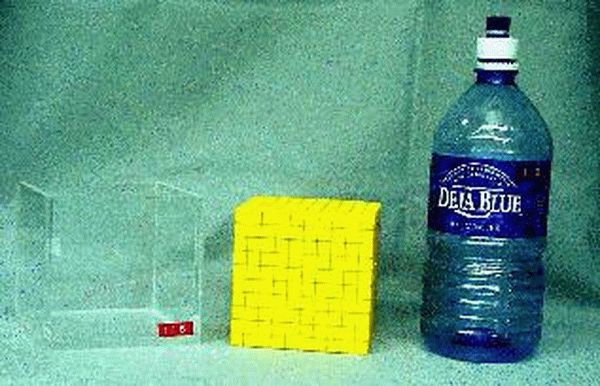
One cubic meter is a cube with sides equal to one meter. Let's build such a cube. If we pour a liter of water into this cube, for example, from an ordinary liter jar or measuring cup, then it will only cover the bottom of this cube. And the answer to the question: How many liters are in 1 cubic liter? - we can only get it if we fill this cube to the top.
It is clear that no one wants to run with a liter jar from tap to cube. Therefore, you can use a bucket or simply build a smaller cube. We all know how to count and we know for sure that the easiest way is to divide by 10. So let’s build a cube with a side of a decimeter. Our jar filled this cube to the top! Hooray!

Now you can simply calculate how many liters of water are in one cube. If one liter is equal to one cubic decimeter, then you just need to calculate how many of these cubic decimeters are in a cubic meter. If you take a square, you can quickly calculate - there are exactly 100 of them, that is, 10 to the second power. But we have not a square, but a cube. Therefore, how many liters are in 1 cube of water? That's right, exactly 1000.
Would you be persistent enough to run 1000 times with a liter jar? I doubt. And mathematics, or rather even arithmetic, helped to get by with just one trip for water. Now we know exactly how many liters are in 1 cubic meter of water. All that remains is to convert cubic meters into cubic kilometers, and you can calculate what the reserves of fresh water are on our planet.
Another interesting fact is that one liter of pure water (distilled) under normal conditions weighs exactly one kilogram. This means now, knowing how many liters are in 1 cubic meter of water, we can calculate the total weight of fresh water on the planet. And if you want to find out the total weight of water in all seas and oceans, then you will have to take into account that the density of salt water is higher than fresh water, therefore a liter of salt water should weigh more.
Per month, per person, at reduced rates, four cubic meters of water are provided. And how much will it be in liters, in other words: how many liters are in a cubic meter of water? In connection with the reform of housing and communal services and the widespread installation of meters for cold and hot water, this question is not at all idle.
One cubic meter of water is, as the name suggests, one cubic meter or a cube with sides equal to 1 meter.
A liter is a measure of volume and can be represented as a cube with sides equal to one decimeter or ten centimeters.
It is not difficult to imagine that 1000 of these liter-cubes will fit in a cubic meter.
Thus, one cubic meter of water is equal to a thousand liters.
So we can safely spend as much as four thousand liters of water a day on ourselves, which is quite enough for showering and cooking.
Remembering the school physics course, we ask ourselves the question: how much does a cubic meter of water weigh?
This is interesting: Electric meter Neva: connection diagram 2020
Well, it’s quite simple: 1 liter – 1 kg. water.
Accordingly: a thousand liters or a cubic meter is a thousand kilograms, i.e. a ton.
However, when calculating how many liters are in one cube, it is necessary to remember that a cubic meter of water weighs a thousand kilograms at normal atmospheric pressure (760 mm Hg) and at a temperature of 3.8 ° C (maximum density of water).
Thus, it is not difficult to guess that at zero degrees the same cubic meter will weigh a little less, namely 999.9 kg.
In our calculations, we take it for granted that one liter of water weighs one kilogram.
For this kind of problem this is true; a small error does not matter.
When solving more complex problems, it is necessary to know exactly how much 1 liter of water weighs.
Water can contain a large number of impurities, and then a liter will not weigh at all a kilogram.
How much does water weigh, for example on Mars? Weight, unlike mass, depends on the gravitational force of the planet.
This means that on Mars a liter of water would weigh approximately 377 grams, but in zero gravity it would weigh nothing at all!
how much water is in one cubic meter
- 1000 liters. 1 ton.
- 1000liters
- 1000 litrav
- 500 probably
- 1 meter cubed 1 liter of water
- 1 cubic meter of water weighs 1 ton
- It seems to me 100 liters! Of course I could be wrong!
- 2000 bottles #8230 Yo-moe #8230 let's have a good walk. Join everyone!
#8230 -One hundred mirrors were placed in one hundred squares#8230 how many mirrors are there in all squares#8230
- Yes, you are half a fool. ho-ho-ho-ho-ho#8230 #187
Kingdom of Crooked Mirrors#187
There is 1 cubic meter of water in one cubic meter, or:
Many mathematical problems require converting one unit of measurement to another. In this article we will talk about volume and how it is measured in units such as cubic meters and liters. How to convert cubic meters to liters. How to solve problems in which the question is how many liters are in a cube of water?
Let us remember what the terms that we use to solve such problems mean.
Volume is usually called that quantitative part of space that a certain body or substance occupies. Volume depends on two quantities - the shape and size of the body.
Now we are talking about a body shape like a cube. Let us also recall that a cube is a parallelogram in which all faces are equal and are squares. The volume of a cube is usually measured in cubic centimeters, meters and decimeters - and these are the dimensions of the body. What about liquids? How to convert liters to cubic units of measurement?
One liter of water will contain 0.001 cubic meters.
In turn, the French “litron” is a derivative of the Greek word “litra”, which was the name of a silver coin. And the weight unit “litra” was the amount of olive oil that could be bought with this coin - approximately 1/3 of a modern liter.
In 1964, the 12th Conference on Weights and Measures adopted the definition: 1 liter is equal to 1 cubic meter. decimeter. (Before this, 1 liter was equal to 1 kilogram of water at a certain pressure and temperature.)
If you need to determine how many liters are in one cubic meter, or make other calculations with the measure of liter, then our online converter will help you carry out the necessary operations.
Water is one of the most important elements on our planet. If a person can live without food for several weeks, then the lack of fluid will lead to death within a couple of days. It is not surprising that it is important to be able to make calculations for this vital element. For example, it is worth finding out how many liters of water are in 1 cubic meter.
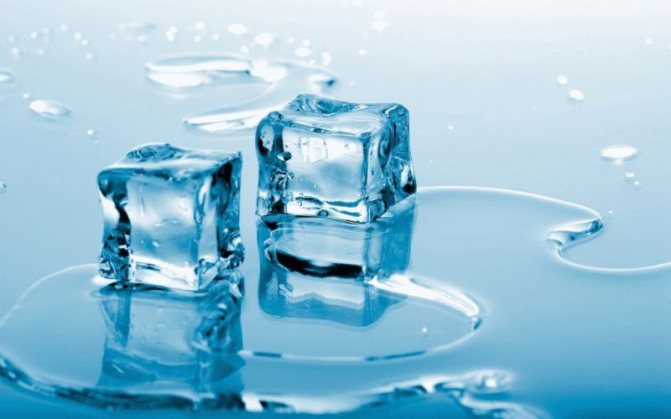
When a “cube” is mentioned in calculations, we are not talking about some simple square figure of any size. Yes, their walls themselves can reach any number of centimeters and millimeters, but the formulas consider something else.
The concept of cubic meter is adopted in the International System of Units, otherwise known as SI. This modern version of the metric system is used in everyday life, in the exact sciences and technical matters. Such designations are used in most countries in the world. Even if in everyday life the inhabitants of some places use other units, for scientific questions they still use SI.
In addition to the International System of Units, the cubic meter is represented in the ICGSS and MTS. Unlike any free chosen kuda, all its edges will be equal to one meter . Thus, this unit of volume has the same size as the space inside this figure, the length of the edges of which is a meter.
This measure is denoted as m3 in Russian, and the international equivalent is m3. The word itself was formed from a combination of the terms cube and meter, which are key to understanding this unit.
Using the metric system, cubic meter is easily converted to other units. It will not be difficult to find out how many decimeters, centimeters, millimeters and even liters it contains. Let's take a closer look at the last aspect.
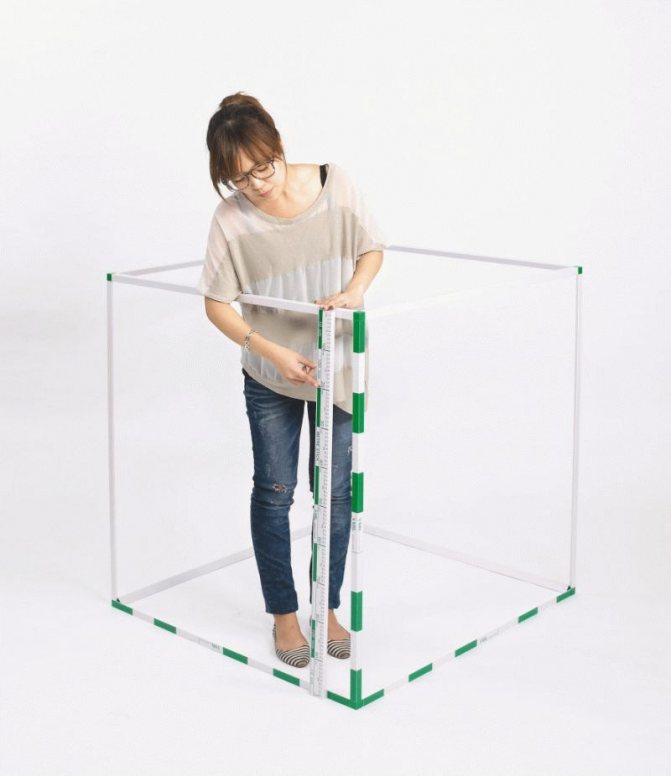
The concept of a cubic meter in relation to water is especially important, because this is how tariffs are calculated. That is, with the help of these units it is determined how much liquid a person has consumed in a month, and, accordingly, how much he must pay for this service.
In addition, cubic meters also count other products, such as wood, concrete, bulk and gaseous substances. However, it is worth dwelling in more detail on the issue of water. Finding the answer to the question of how many liters of water are in 1 cube is not difficult, but you need to understand that the solution to such a problem is somewhat relative . The amount of liquid will be easily affected by pressure, temperature and other aspects, so the figure should be considered conditional.
In order to find out how much water can fit in one cube, you need to pay attention to the density of a given element. It is 100 kg/m3. This value can be converted into other units such as grams, cubic centimeters and millimeters. This will give you 1 g/cm3 and 1 g/ml.
Calculations can be made using cubic decimeters. One meter will contain 1000 dm3. Using this figure, you can easily calculate the number of liters per cubic meter.
The fact is that each liter of water is equal to one cubic decimeter, and since a meter contains 1000 dm3, it is not difficult to make calculations. Thus, it turns out that a thousand liters of water can fit in one cubic meter . You can make a translation, and then one liter will equal 0.001 m3.
Very often, questions about the content of liters in cubes arise due to the need to solve various mathematical problems. For most of them, it is enough to simply know that one cube contains a thousand liters of water, but sometimes it is necessary to make calculations, including reverse ones.
For example, knowing how many liters of water a bathtub contains, you can find out how many cubic meters it contains.
- Let's assume that the volume of the bath is 400 liters.
- One liter equals 0.001 m3.
- You need to find out how many such meters there will be in 400 liters.
The solution occurs through proportion, that is, the indicators are multiplied crosswise. 400*0.001=0.4 m3 . This is how you can easily find out the number of cubic meters.
Let's consider the opposite example, using an aquarium with a volume of 1.4 m3 as a basis. How do you know how many liters of liquid it will take to completely fill it? In this case, proportion will come to the rescue again. To make it easier to cross-calculate, you can write the data as follows:
Now all that remains is to multiply the correct numbers. You need to take 1.4 and 1000. Multiplying them will give 1400 liters, which will be the answer to this problem.
In order to easily deal with any questions related to cubic measures and liters, it is worth remembering a few more common units.
This data will help you easily solve problems and other issues related to such measures.
»
Counters
Accreditation for verification of water meters 2020
Read more
Counters
Antimagnetic seal for the electric meter 2020
Read more
Counters
Introductory machine before or after the counter 2020
Read more
Counters
Gas meter SGMN 1 G6 - technical characteristics and advantages 2020
Read more
Great article 0


